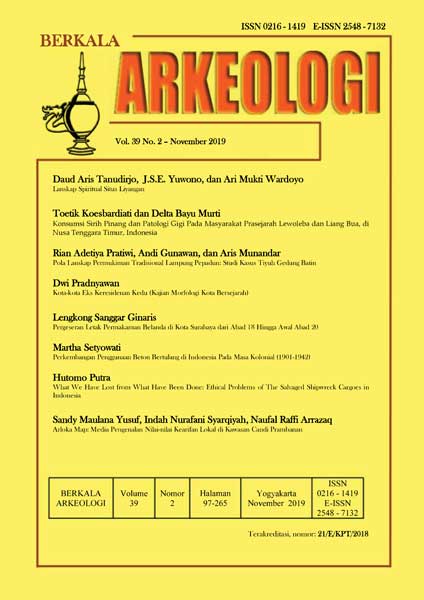PERGESERAN LETAK PERMAKAMAN BELANDA DI KOTA SURABAYA DARI ABAD 18 HINGGA AWAL ABAD 20
Main Article Content
Abstract
One of the remains of the colonial period in Indonesia is the Dutch cemetery. The Dutch cemetery have splendid tombs, western-style decorations and gravestone written in Dutch. Dutch cemeteries can be find in cities such as Surabaya. During colonial period, Surabaya had four Dutch cemeteries in Jembatan Merah, Krembangan, Peneleh and Kembang Kuning. The aim of this study is to determine factors behind the displacement of the Dutch cemetery in Surabaya. The data in this study are including not only historical data (maps of Surabaya in 1787, 1825, 1866, and 1934), but also archives. The remaining observable cemeteries are in Peneleh and Kembang Kuning, because the Dutch cemeteries at Jembatan Merah and Krembangan have been demolished. Data from the observation are then sorted and analyzed to determine the displacement pattern and the factors behind them. The results show that there have been three Dutch cemetery displacements in Surabaya, triggered by three factors: health, unstable ground condition, and land conversion into settlement.
Article Details

This work is licensed under a Creative Commons Attribution-NonCommercial-ShareAlike 4.0 International License.
References
Ambary, Hasan Muarif. (1998). Menemukan Peradaban, Jejak Arkeologis dan Historis Islam Indonesia. Jakarta: Logos Wacana Ilmu.
Anshcuetz, Kurt.F. Wilshusen, Richard. H dan Sheick, Cherie.L. (2001). An Archaeology of The Landscape: Prespective and Directions. Journal of Archaeology Research, Vol. 9, No.2: 157 -211.
Balai Arkeologi Yogyakarta. (1998/1999). “Keletakan dan Bentuk Makam-Makam Belanda pada Kota-kota Pantai (Tahap I). Departemen Pendididikan dan Kebudayaan.
Branto, Nicole. (2009). “Landscape Approaches in Historical Archaeology: The Archaeology of Places†dalam Majewski, Teresita dan Gaimster, David. International Handbook of Historical Archaeology, 51-65. New York: Springer.
Francaviglia, Richard V. (1971). The Cemetery as an Evolving Cultural Landscape. Annals of the Association of American Geographers, Vol. 61, No. 3: 501-509.
Kerrigan. Michael. (2017). Sejarah Kematian ; Tradisi Penguburan dan Ritus-ritus Pemakaman dari Zaman Kuno sampai Zaman Modern. Jakarta : Elex Media Computindo.
Leushuis. Emile. (2014). Panduan Jelajah Kota-kota Pusaka di Indonesia. Yogyakarta : Penerbit Ombak.
Mahendrani, Cahya Ratna. (2013). Nisan Makam Belanda Peneleh Surabaya ; Kajian Tentang Bentuk dan Ragam Hias. (Skripsi). Yogyakarta : Fakultas Ilmu Budaya Universitas Gajah Mada.
Mytum, Harold. (1989). Public Health and Private Sentiment: The Development of Cemetery Architecture and Funerary Monuments from the Eighteenth Century Onwards. World Archaeology, Vol. 21, No. 2: 283 – 297.
Nurhadi. (1987). Arkeologi Kubur Islam di Indonesia. Jakarta: Pusat Penelitian Arkeologi Nasional.
Poldervaart, A. (1933). " De Nieuwe Europeesche Begrafplaats te Bandoeng " dalam Locale Techniek no.4 bulan Oktober 1933.
Shinta, Desril Riva. (2010). “Ragam Hias Bong Cina di Kompleks Ku Tiong Laya Kota Cirebon†dalam Wahyudi, Wanny Rahadrjo (ed), Dari Masa Lalu Ke Masa Kini, 128-144. Sumedang: Penerbit Alqaprint.
Suratminto, Lilie. (2008). Makna Sosio-Historis Batu Nisan VOC di Batavia. Jakarta: Wedatama Widya Sastra.
Tantomi, Ade Faizel. (2013). Bentuk-Bentuk Nisan Belanda di Kerkhof Purworejo. (Skripsi). Yogyakarta: Fakultas Ilmu Budaya Universitas Gajah Mada.
Widodo, Dukut Imam. (2002). Soerabaia Tempo Doeloe. Surabaya: Dinas Pariwisata.
Von Faber, G.H. (1932). Oud Soerabia ; De Geschiedenis van Indies Eerste Koopstad van de Oudste Tijden tot de Instelling van Den Gemeenteraad. Surabaya: Gementee Soerabaia.
Von Faber, G.H. (1932). Nieuw Soerabia ; De Geschiedenis van Indies Voornaamste Koopstad in De Eerste Kwareeuw Sedert Hare Instelling 1906-1931. Surabaya: N.V. Boekhandel en Drukkerij H.van Ingen.

